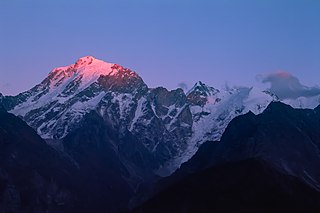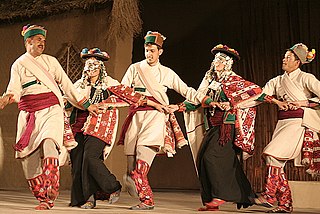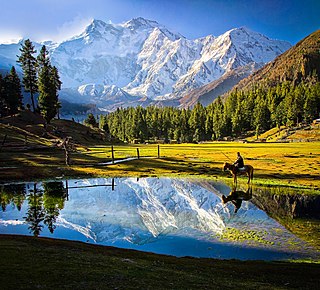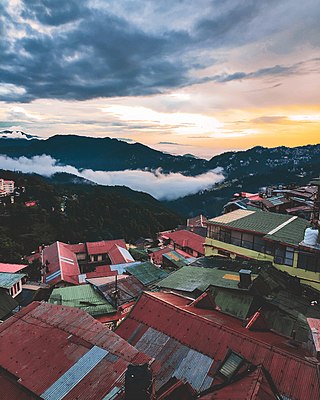
Himachal Pradesh is a state in the northern part of India. Situated in the Western Himalayas, it is one of the thirteen mountain states and is characterised by an extreme landscape featuring several peaks and extensive river systems. Himachal Pradesh is the northernmost state of India and shares borders with the union territories of Jammu and Kashmir and Ladakh to the north, and the states of Punjab to the west, Haryana to the southwest, Uttarakhand to the southeast and a very narrow border with Uttar Pradesh to the south. The state also shares an international border to the east with the Tibet Autonomous Region in China. Himachal Pradesh is also known as Dev Bhoomi or Dev Bhumi, meaning 'Land of Gods' and Veer Bhoomi which means 'Land of the Brave'.

Kullu is a district in Himachal Pradesh, India. It borders Shimla district to the south, Mandi and Kangra districts to the west, Kinnaur to the east and the Lahaul and Spiti district to the north and east. The largest valley in this mountainous district is the Kullu Valley. The Kullu valley follows the course of the Beas River, and ranges from an elevation of 833 m above sea level at Aut to 3330 m above sea level at the Atal Tunnel South Portal, below the Rohtang Pass. The town of Kullu, located on the right side of the Beas River, serves as the administrative headquarters of the Kullu district. The Kullu district also incorporates several riverine tributary valleys of the Beas, including those of the Parvati, Sainj, and Tirthan rivers, and thus some regions somewhat distant from the Kullu valley. The economy of the district relies mainly on horticulture, agriculture, tourism, and traditional handicrafts.

The Lahaul and Spiti district in the Indian state of Himachal Pradesh consists of the two formerly separate districts of Lahaul and Spiti. The present administrative center is Kyelang in Lahaul. Before the two districts were merged, Kardang was the capital of Lahaul, and Dhankar the capital of Spiti. The district was formed in 1960 and is the fourth least populous district in India. It is the least densely populated district of India, according to the Census of India 2011.

Bushahr, also spelt as 'Bashahr' and 'Bussahir' or 'Bushair' was a Rajput princely state in India during the British Raj. It was located in the hilly western Himalaya promontory bordering Tibet.

The state of Himachal Pradesh is spread over an area 55,673 km2 (21,495 sq mi) and is bordered by Jammu and Kashmir and Ladakh on the north, Punjab on the southwest, Haryana on the south, Uttarakhand on the southeast, a small border with Uttar Pradesh in the south, and Tibet on the east. Entire Himachal Pradesh lies in the mountainous Himalaya region, rich in natural resources

Chamba is a town in the Chamba district in the Indian state of Himachal Pradesh. According to the 2001 Indian census, Chamba has a population of 20,312 people. Located at an altitude of 1,006 metres (3,301 ft) above mean sea level, the town is situated on the banks of the Ravi River, at its confluence with the Sal River.

Spiti is a high-altitude region of the Himalayas, located in the north-eastern part of the northern Indian state of Himachal Pradesh. The name "Spiti" means "The middle land", i.e. the land between Tibet and India. Spiti incorporates mainly the valley of the Spiti River, and the valleys of several rivers that feed into the Spiti River. Some of the prominent side-valleys in Spiti are the Pin valley and the Lingti valley. Spiti is bordered on the east by Tibet, on the north by Ladakh, on the west and southwest by Lahaul, on the south by Kullu, and on the southeast by Kinnaur. Spiti has a cold desert environment. The valley and its surrounding regions are among the least populated regions of India. The Bhoti-speaking local population follows Tibetan Buddhism.
Himachal Pradesh, although railways and airways serve very limited transport needs, the road network of the state serves the transport needs of the people. Although, the geography of Himachal presents considerable challenge to the development of transport infrastructure, it has the highest road density among all the Hill States of India. Himachal also has 3 airports, 2 narrow gauge rail tracks and couple of other under-construction broad gauge railway tracks, but roads remain the main mode of transport.
Among arts and crafts that come out of Himachal Pradesh state in India are carpets, leather works, shawls, metalware, woodwork and paintings. Pashmina shawl is the product which is highly in demand not only in Himachal but all over the country. Colourful Himachali caps are also famous art work of the people. One tribe, Dom, is expert in manufacturing bamboo items like boxes, sofas, chairs, baskets and racks. Metalware of the state include utensils, ritualistic vessels, idols, gold and silver jewelleries.
The traditional dances of Himachal Pradesh are very complicated. These dances are a vital part of tribal life. It reflects the culture and the tradition of Himachal. Hardly any festivity there is celebrated without dancing. Dance forms such as Nati are performed all over the region.

Kaza, also spelled Kaze, Karze, Karzey, is a town and the subdivisional headquarters of the remote Spiti Valley in the western Himalayas in the Lahaul and Spiti district of the northern Indian state of Himachal Pradesh. Spiti is a high altitude or cold desert having close similarities to the neighbouring Tibet and Ladakh regions in terms of terrain, climate and the Buddhist culture. Kaza, situated along the Spiti River at an elevation of 3,650 m (11,980 ft) above mean sea level, is the largest township and commercial center of the Spiti valley.

The word Nati is used for the traditional folk songs sung in the Western and Central Hills of the Indian subcontinent. It is primarily native to the states of Himachal Pradesh and Uttarakhand. Nati is traditionally performed in the Kullu, Shimla, Sirmaur, Kinnaur, Dehradun, Tehri Garhwal, Uttarkashi. However, due to high immigration of ethnic paharis in the plains, this has been made popular in the plains too. Nowadays many consider pahari dance as nati but it actually corresponds to pahari songs. Traditionally, locals dance to the beats of percussion instruments called Dhol-Damau. Pahari dance is listed in the Guinness Book of World Records as largest folk dance.

The Bodh people, also known as Khas Bhodi, are an ethnic group of Himachal Pradesh, India. They are found in Lahaul tehsil, Lahaul and Spiti district, predominantly in the Bhaga and Chandra valleys, but also to a lesser extent in Pattani valley, Miyar Valley, in the upper reaches of Pangi, Himachal Pradesh and Paddar valley, Jammu and Kashmir. Their religion is predominantly Buddhism with animistic and shaivite practices. Caste wise, they are identified as Rajput, Thakur or Kshetri although caste rules are not as rigid as in the plains. Historically, 3-4 prominent families of the area were accorded the titles of Rana, Wazir or Thakur by the kings of Chamba, Kullu or Ladakh for the purpose of general administration and revenue collection. They have a mix of martial traditions alongside shamanistic and lamaistic beliefs. Certain families/clans used to be significant zamindars/jagirdars. There is a significant cultural and ethnic mixing due to the region passing under the hegemony of rulers of Ladakh, Kullu and Chamba over the last many centuries. The language spoken differs from valley to valley with some dialects being very close to Kumaoni, while others are mixed with Chambyali and Dari. They are progressive, enterprising, honest and were involved in the centuries old India-Tibet-Nepal trading routes. Organized into family groups/clans with clan names ending in the suffix "-pa" similar to the "-ta" suffix found in the family/clan names of the Simla area.

The Western Himalayas refers to the western half of the Himalayas, in northwestern India and northern Pakistan. Four of the five tributaries of the Indus River in Punjab rise in the Western Himalayas; while the fifth, the Sutlej cuts through the range after rising in Tibet.

Tourism in Himachal Pradesh relates to tourism in the Indian state of Himachal Pradesh. This is popularly renowned for its Himalayan landscapes and popular hill-stations. Many outdoor activities such as rock climbing, mountain biking, paragliding, ice-skating, trekking, rafting, and heli-skiing are popular tourist attractions in Himachal Pradesh.

National Highway 505, commonly called NH 505, is a national highway in India. It is a spur road of National Highway 5. NH-505 traverses the state of Himachal Pradesh in India. NH505 a high elevation road, covers Kinnaur and Lahaul and Spiti districts of Himachal Pradesh, mainly running along Spiti river in Spiti valley. The highway from Kaza to Gramphu remains closed for 6–9 months in a year due to heavy snowfall and closure of Kunzum La pass at an elevation of 4,550 m (14,930 ft).
Tobdan is a historian and linguist from Himachal Pradesh, India. He is noted for his work on the cultural traditions, histories, and languages of the Lahaul and Spiti district, and some neighboring regions.

Minjar Mela, also known as the Minjar Fair, is a popular annual festival celebrated in the state of Himachal Pradesh in India. The fair is held in the town of Chamba, which is located in the scenic Chamba Valley. Minjar Mela is a week-long event that typically takes place in the month of July. The festival holds great cultural and historical significance for the people of Chamba. It is celebrated to mark the harvesting of the maize crop and to seek blessings for a bountiful year ahead. The highlight of Minjar Mela is the Minjar procession, which is a grand and colorful event. The procession is led by a decorated chariot, accompanied by folk dancers, musicians, and devotees dressed in traditional attire. People from nearby villages and towns join the procession, adding to the festive atmosphere.















